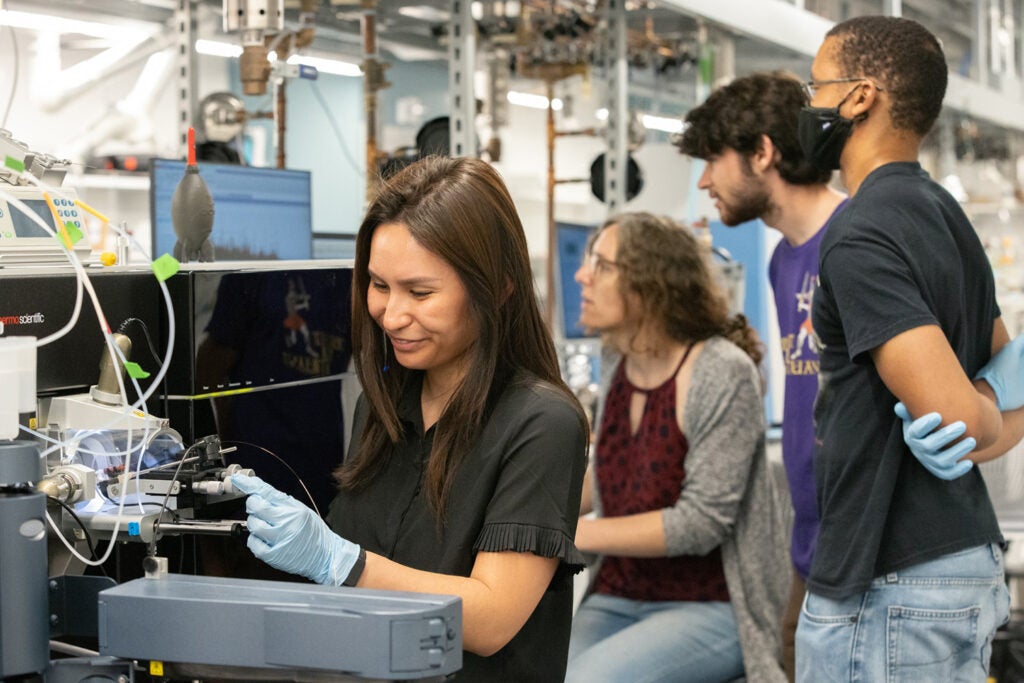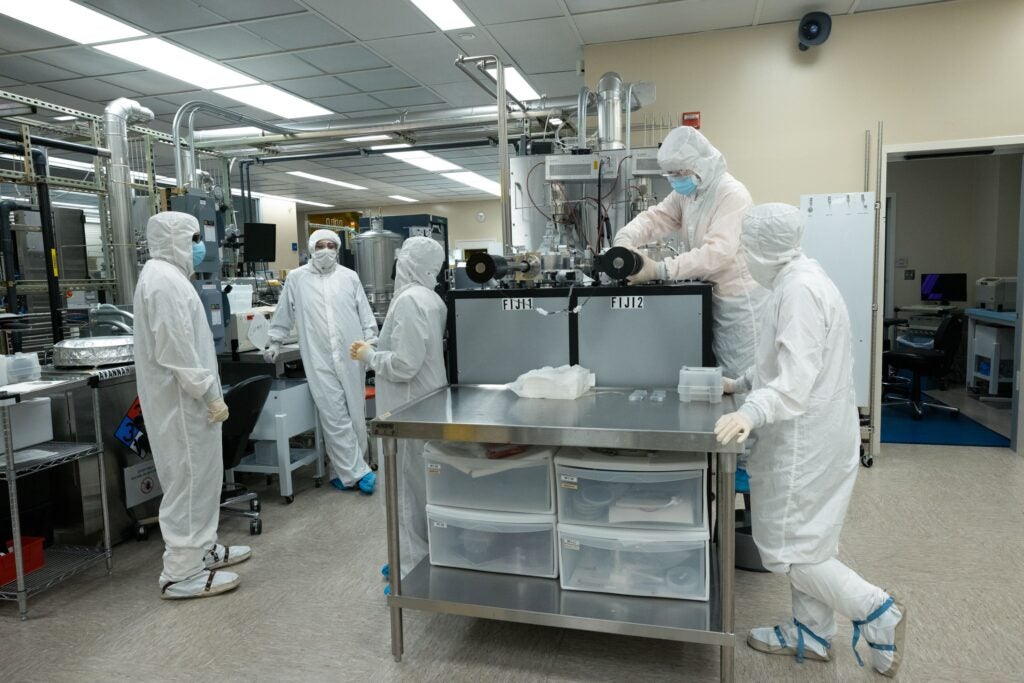c-ShARP Education group connects shared resources with coursework
Grant funding gives faculty the resources to show students how the university’s shared facilities can make an impact on their research and careers.
Tucked away in basements, down long hallways, and in buildings scattered across campus sits billions of dollars in equipment, waiting to help researchers and students create breakthroughs in myriad fields.

Postdoctoral scholar Arianne Caudal and research scientists Norah Brown, Soren Faulkner, and Garvey McKenzie using the Orbitrap Eclipse Tribrid mass spectrometer at the Stanford University Mass Spectrometry laboratory. (Image credit: Andrew Brodhead)
Working to make that promise a reality is Stanford University’s Community of Shared Advanced Research Platforms’ (c-ShARP) Education Working Group, which is funding opportunities to bring the skills to operate that equipment into the minds and hands of students across disciplines.
C-ShARP began in October 2020 and is composed of four working groups, each exploring a different aspect of how to use shared resources (also called core facilities) more effectively. The Education Working Group offers funding to support new and existing coursework that teaches students about shared facilities. In fiscal year 2023, the group funded 12 proposals using 16 shared resources and benefiting five schools, for a total of $537,152. It is currently accepting experiential learning proposals for its third round of funding.
“This is not something that’s available elsewhere; it’s a new way of giving students access to, in many cases, multi-million-dollar equipment that they’d never normally see,” said Ryan Leib, Director of Proteomics for the Stanford University Mass Spectrometry (SUMS) laboratory. Leib co-leads the Education Working group with SUMS Director Allis Chien. “Now they can access it, learn from it and it will help them as they move into the rest of their career.”
The c-ShARP network is open to all of Stanford’s shared resources. Early involvement includes those covering earth sciences and sustainability; human performance and health sciences; cryo-electron microscopy; neuroscience; translational applications science; nanofabrication, and more.
“Depending on how you count them, there are 35-70 shared resources at Stanford,” Chien said. “There’s a lot of growth potential for our partnerships.”
Opening up new careers
H. Tom Soh, professor of electrical engineering, of radiology, and of bioengineering, received a c-ShARP grant to create the course, Analytical Methods in Biotechnology II (EE235B). The class teaches engineering graduate students advanced techniques with biotechnology equipment. It’s a follow-up course to Analytical Methods in Biotechnology I (EE235A). In that class, engineering students – ranging from mechanical to electrical to computer science – have their first opportunity to get hands-on with molecular biology techniques, such as CRISPR and next-generation DNA sequencing.
Before moving into academia, Soh was a classically trained electrical engineer working in telecommunications. A personal medical event shifted his focus to medicine, and he joined the Stanford faculty in 2015.
“When you work on something that you have no background in, sometimes it can be a very good thing because you aren’t encumbered by the conventional frameworks of what’s possible and not possible,” Soh said. He created EE235A to enable engineering students to see what’s possible in their own careers. “I know what their background is because it’s my background. I know what they don’t know. When I came to Stanford, I asked, ‘Would it be possible to give these talented students the experience that I had to piece together for myself over the past two decades – in one quarter?’ ”
In the c-ShARP-funded course, Soh worked with four core facilities. In the class, students conducted a series of experiments where each one built on the previous using a different core facility, with about two weeks spent in each.
The knowledge opens doors not only to additional research questions, but also careers.
“After this course, their job opportunities open up. There are a lot of biomedical and biotech companies who need engineers who can speak multiple languages – hardware, algorithms, and molecules,” Soh said. “They might go on to careers they wouldn’t even have known about.”
Supporting new programs
The Education Working Group left the funding call open-ended to allow for proposals that support and grow existing coursework – like Soh’s class – and those supporting brand-new experiences.
One of those is a course in the School of Medicine’s Master’s in Translational Research and Applied Medicine (M-TRAM) program, MED212A/B/C. M-TRAM is a new graduate program at Stanford, led by Dean Felsher, professor of medicine and of pathology, and Executive Director Joanna Liliental, who also directs a core facility, the Translational Applications Service Center (TASC).
“Because of my different roles, I have a unique perspective and motivation to incorporate core facilities training into coursework, and I had already built strong relationships with many core facilities across Stanford,” Liliental said. “When I was designing the M-TRAM curriculum, I thought it was a great idea to involve the core facilities in the educational process. I wanted to incorporate not only the didactic courses, but also skills-based and experiential learning, so we can equip our students with the tools to navigate the complexities of translational research design and methodology.”
The three-quarter MED212 class integrates six core facilities: TASC, Human Immune Monitoring Center (HIMC), Fluorescence Activated Cell Sorting Facility (FACS), SUMS, Stanford Functional Genomics Facility (SFGF), and the High-Throughput Screening Knowledge Center (HTSKC). Through the course, students build a foundational understanding of modern translational research techniques. By working with core facilities, students get expert training, access to enabling technologies, and hands-on experience creating and experimenting with ideas and inventions.

Researchers in the Stanford Nanofabrication Facility cleanroom. (Image credit: Andrew Brodhead)
The first M-TRAM cohort was comprised of six students, with 11 more joining in the upcoming academic year. Feedback on the new course was overwhelmingly positive, Liliental said.
“Some students said it was the best experience they ever had. Experiential learning is awesome because it empowers students with an immersive and dynamic learning environment and teaches them practical skills. Instead of just reading or listening to lectures, students engage in active participation, becoming deeply involved in the learning process, hands-on,” she said. “They were grateful for the opportunity to have hands-on training and appreciate the fact that they can work with expert scientists from these shared resources and have access to those cutting-edge tools.”
Spreading the word
The enthusiasm for c-ShARP’s educational efforts is readily apparent. One faculty member prepared for four students in her course, but received two dozen applications. Another planned for a dozen students, and then had an additional 26 post-docs and a faculty member audit the class, and a waiting list of several dozen others.
“We’re hearing across the board that the level of interest students have is huge, but the challenge for us is how to make that available,” Chien said. “There are limitations to the spaces, the faculty and staff available to teach them, and the time on the tools themselves.”
Classes wanting to train on the equipment have to find time alongside researchers and other facility demands. The spaces themselves are often physically small, supporting only a handful of people at one time.
It’s an opportunity for the Education Working Group and core facility leaders to get creative.
“As this educational program continues to grow, so will the need for staffing to serve student demand,” Leib said. “It’s really hard to turn people away. When these classes fill up in a handful of minutes, that means there are students who would really like to learn, and we want to find a way to not make them wait a year or more.”
The group is looking at alternative approaches, such as open houses and engagement events, as well as cross-core workshops and training aimed at staff and faculty from the facilities to further enhance the knowledge of what’s possible in Stanford’s shared resource labs. That will help staff point students toward additional useful resources for their experiments.
“We’re excited about ways to get students to even know these resources exist,” Leib said. “One of our goals is just outreach and making people aware, so they aren’t trying to reinvent the wheel in their own laboratory. They don’t have to feel adrift – they can know that two buildings over, there’s equipment and expertise they need and they have the ability to access it.”